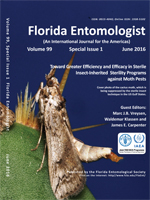The sterile insect technique (SIT) requires the release of a large number of irradiated moths in the infested crop area targeted for suppression or eradication. Irradiated males must compete strongly with wild males for mating with conspecific wild females. Irradiated female moths are fully sterile and therefore when released do not pose a potential risk to the crop. However the close proximity of the released males and females may result in assortative mating among the irradiated moths, thereby undermining the competitive ability of the irradiated males. Furthermore, released females have partially depleted the reproductive potential of the colony, and will not contribute to further increases in the size of the colony in a mass-rearing facility. We tested 4 methods to separate European grapevine moth, Lobesia botrana (Dennis & Schiffermüller) (Lepidoptera: Tortricidae) males from females based on differences between males and females with respect to: (i) the number of abdominal segments of the pupae, (ii) the colors of wandering larvae, (iii) speed of maturation of larvae (protandry), and (iv) the lengths of the pupae. The sexing of 500 moths by the number of abdominal segments in the pupae was accomplished without any errors, but it was time consuming, tedious and required skill and experience. However, it should be possible to develop an automated apparatus to sort pupae by gender. Sexing by color differences did not provide clean separation because of large overlaps between the sexes in the green, blue and red spectra. Although male larvae entered the wandering phase significantly earlier than female larvae, in a large portion of the population the time of departure, some males and females departed simultaneously so that clean separation was possible for only about ¼ of the males or about ¼ of the females. A similar situation prevailed for emergence of adult males and females from pupae. On average, male pupae were significantly shorter than female pupae, and pupal length was found to be the most practical method for separating L. botrana males from females. For example, if all pupae < 5.4 mm were irradiated and released, they would include about 86% of all males and about 22% of all females—all of which would be the smallest and least fecund ones. This would allow about 78% of the females—including the largest and most fecund ones—to be retained for mass-rearing. At this time separation of the sexes based on pupal length is the most practical method.
How to translate text using browser tools
1 June 2016
Methods to Separate Lobesia botrana (Lepidoptera: Tortricidae) Males from Females for the Implementation of Sterile Insect-Inherited Sterility Technique Control Tactics
Hadass Steinitz,
Adi Sadeh,
Martin Tremmel,
Ally R. Harari

Florida Entomologist
Vol. 99 • No. sp1
Jun 2016
Vol. 99 • No. sp1
Jun 2016
color de las larvas
Dimorfismo sexual
European grapevine moth
larval color
longitud de pupa
polilla europea de la vid
polillas estériles




